KirstyF
Member
As some of you may know, following a chlorosis issue, I’ve been running a number of dosing tests in my tank.
These have been centred primarily on Fe, and specific to chlorosis, in my hardwater tank, but I’ve put plant deficiencies in the thread title as I’m more than happy to open the thread to any other types of deficiencies that people may wish to discuss and am also very interested to hear other people’s experiences or contributions in regard to this subject matter.
I should also note that chlorosis can be caused by other nutrient deficiencies so Fe is not always the answer.
Background info for Fe:
Fe EDTA - stable up to Ph 6.3
Fe DTPA - stable up to Ph 7
Fe EDDHA - Stable up to Ph 9
Fe Gluconate - unchelated so will only be available for a short period in hard water/higher Ph environment.
Note: All dosing changes were run for a minimum of 3 weeks (sometimes more) to monitor response.
I’ll start with my tank parameters:
700l High Tech with 12 x flow on paper; in reality somewhat less. (2 x Oase 850 thermo - 2x Maxspect gyres)
Gh/KH estimated at 10-12 (KH not available on my water report but estimates supported by Darrel’s, @dw1305 , knowledge of geology)
Ph - tap 7.6 - The ph in the tank sits at a steady 6.6 after Co2, and I believe rarely gets above 7.2
Macro Dosing
No3 - 20-30ppm from tap - no additional dosing
Po4 - now 6ppm but just 2ppm at outset of this trial
K - now 15ppm but around 7ppm at outset of this trial
Mg - 10ppm
Macros frontloaded
Micro Dosing (at outset of trial)
My micros used to be up to 5x the dosing below (depending on nutrient) but seeing friends here with much leaner micros, I wanted to see results of a reduction.
Fe (DTPA 8%) 0.1ppm
Mn 0.15 ppm (this was originally 0.1ppm but was increased shortly after chlorosis set in, to exclude it as a cause)
B 0.02ppm
Mo 0.005ppm
Zn 0.02ppm
Cu 0.006ppm
Micros dosed 3xpw
Perhaps unsurprisingly, in my hard water, the result of Fe at 0.1ppm was a pretty rapid onset of chlorosis. Note however that we have colleagues successfully running beautiful soft water tanks at that level.
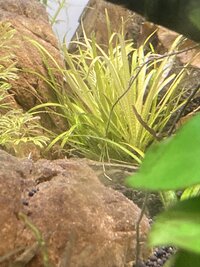
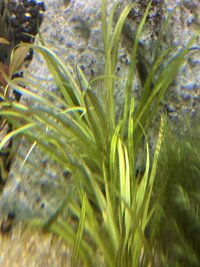
First fix was to up the DTPA to 0.3ppm - no improvement
Second fix was to try DTPA at 0.1ppm plus EDDHA at 0.2ppm to maintain a 0.3ppm total - no improvement
3rd fix was DTPA at 0.15ppm (in the macro solution) plus what I thought was 0.1ppm of Fe gluconate, dosed on opposite days to the Micro
I have since had it pointed out that Seachem bottle instructions are a little misleading and this dose was actually 0.25ppm. I clearly wasn’t paying attention there 🤪 so total dose was actually 0.4ppm - almost immediate and dramatic improvement
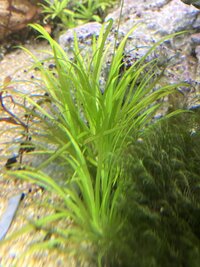
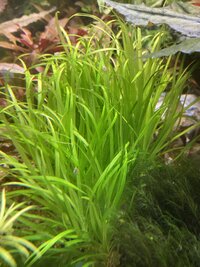
It was at this point that I increased P&K, as noted above, as I had some long term, minor but fairly annoying GSA on slow growers. (Way prior to the chlorosis issue) This worked out pretty well too but that’s another story.
So, next move was to add the gluconate dose into the micro mix, rather than dosing separately to see if it responded differently. Difficult to tell if there was much difference - greens possibly slightly less bright.
I now wanted to test ‘Fe only’ to establish how much benefit may still be being derived from that part dose of DTPA or whether the impact was all about the gluconate, but to do that, I needed to induce chlorosis again.
Moved back to 0.3ppm DTPA/no gluconate - early signs of chlorosis apparent within 3 weeks.
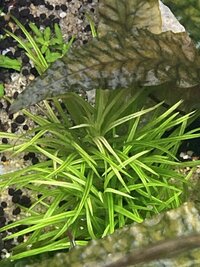
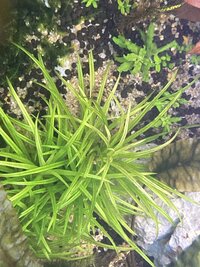
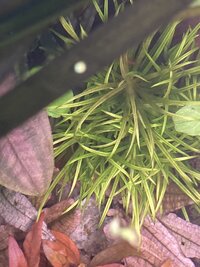
0.3ppm of Fe gluconate only is being tested right now and results are to follow. If results are good, I then plan to reduce incrementally to establish the level at which it starts to fail.
I also still want to do some further comparison tests between daily and 3xpw dosing and also exactly what dosage/frequency of ‘DTPA/EDDHA only’ will match the results of gluconate, so this will be ongoing for a while yet.
We may get to something like…X ppm of Fe gluconate dosed at X frequency delivers the optimum response….or ultimately we may conclude otherwise but…..we’ll see.
What does this tell us so far….
0.3ppm of DTPA Fe is not enough for my tank. I feel it kinda should be……0.5ppm is max EI level which is designed to be well over what any tank could ever need based on Uber lights and hungry stems….and mine is middling light and mixed planting. Equally there are others using those higher levels and still struggling….and, tbf, clearly some who aren’t.
EDDHA is maybe not the answer either.
(A bit more testing on ‘EDDHA only’ is needed)
Possibly that an entirely unchelated Fe solution, may actually be super helpful in a hard water environment (despite this being counterintuitive) The hypothesis being that, as this product is already in the form that the plants require, it can be rapidly taken up despite limited availability time. Note: My dosing takes place about 1hr into photoperiod when the plants are ready to suck it in. Dose 1hr before lights kick in and it would likely be largely gone by the time the plants wanted it.
Also that I appear to have suffered no detriment or deficiency from the reduction in all of the other micros that I was previously using, which seems to evidence that I certainly didn’t need those levels.
I think it’s too early to conclude any more than that right now but welcome input/data/photos etc for further discussion.
I will collate and store anything that comes in so please add detail particularly regarding ppm’s and Ph levels, and I’ll continue to update with test results. Happy to take suggestions on testing parameters too. 😊
Over to you folks.
These have been centred primarily on Fe, and specific to chlorosis, in my hardwater tank, but I’ve put plant deficiencies in the thread title as I’m more than happy to open the thread to any other types of deficiencies that people may wish to discuss and am also very interested to hear other people’s experiences or contributions in regard to this subject matter.
I should also note that chlorosis can be caused by other nutrient deficiencies so Fe is not always the answer.
Background info for Fe:
Fe EDTA - stable up to Ph 6.3
Fe DTPA - stable up to Ph 7
Fe EDDHA - Stable up to Ph 9
Fe Gluconate - unchelated so will only be available for a short period in hard water/higher Ph environment.
Note: All dosing changes were run for a minimum of 3 weeks (sometimes more) to monitor response.
I’ll start with my tank parameters:
700l High Tech with 12 x flow on paper; in reality somewhat less. (2 x Oase 850 thermo - 2x Maxspect gyres)
Gh/KH estimated at 10-12 (KH not available on my water report but estimates supported by Darrel’s, @dw1305 , knowledge of geology)
Ph - tap 7.6 - The ph in the tank sits at a steady 6.6 after Co2, and I believe rarely gets above 7.2
Macro Dosing
No3 - 20-30ppm from tap - no additional dosing
Po4 - now 6ppm but just 2ppm at outset of this trial
K - now 15ppm but around 7ppm at outset of this trial
Mg - 10ppm
Macros frontloaded
Micro Dosing (at outset of trial)
My micros used to be up to 5x the dosing below (depending on nutrient) but seeing friends here with much leaner micros, I wanted to see results of a reduction.
Fe (DTPA 8%) 0.1ppm
Mn 0.15 ppm (this was originally 0.1ppm but was increased shortly after chlorosis set in, to exclude it as a cause)
B 0.02ppm
Mo 0.005ppm
Zn 0.02ppm
Cu 0.006ppm
Micros dosed 3xpw
Perhaps unsurprisingly, in my hard water, the result of Fe at 0.1ppm was a pretty rapid onset of chlorosis. Note however that we have colleagues successfully running beautiful soft water tanks at that level.


First fix was to up the DTPA to 0.3ppm - no improvement
Second fix was to try DTPA at 0.1ppm plus EDDHA at 0.2ppm to maintain a 0.3ppm total - no improvement
3rd fix was DTPA at 0.15ppm (in the macro solution) plus what I thought was 0.1ppm of Fe gluconate, dosed on opposite days to the Micro
I have since had it pointed out that Seachem bottle instructions are a little misleading and this dose was actually 0.25ppm. I clearly wasn’t paying attention there 🤪 so total dose was actually 0.4ppm - almost immediate and dramatic improvement


It was at this point that I increased P&K, as noted above, as I had some long term, minor but fairly annoying GSA on slow growers. (Way prior to the chlorosis issue) This worked out pretty well too but that’s another story.
So, next move was to add the gluconate dose into the micro mix, rather than dosing separately to see if it responded differently. Difficult to tell if there was much difference - greens possibly slightly less bright.
I now wanted to test ‘Fe only’ to establish how much benefit may still be being derived from that part dose of DTPA or whether the impact was all about the gluconate, but to do that, I needed to induce chlorosis again.
Moved back to 0.3ppm DTPA/no gluconate - early signs of chlorosis apparent within 3 weeks.



0.3ppm of Fe gluconate only is being tested right now and results are to follow. If results are good, I then plan to reduce incrementally to establish the level at which it starts to fail.
I also still want to do some further comparison tests between daily and 3xpw dosing and also exactly what dosage/frequency of ‘DTPA/EDDHA only’ will match the results of gluconate, so this will be ongoing for a while yet.
We may get to something like…X ppm of Fe gluconate dosed at X frequency delivers the optimum response….or ultimately we may conclude otherwise but…..we’ll see.
What does this tell us so far….
0.3ppm of DTPA Fe is not enough for my tank. I feel it kinda should be……0.5ppm is max EI level which is designed to be well over what any tank could ever need based on Uber lights and hungry stems….and mine is middling light and mixed planting. Equally there are others using those higher levels and still struggling….and, tbf, clearly some who aren’t.
EDDHA is maybe not the answer either.
(A bit more testing on ‘EDDHA only’ is needed)
Possibly that an entirely unchelated Fe solution, may actually be super helpful in a hard water environment (despite this being counterintuitive) The hypothesis being that, as this product is already in the form that the plants require, it can be rapidly taken up despite limited availability time. Note: My dosing takes place about 1hr into photoperiod when the plants are ready to suck it in. Dose 1hr before lights kick in and it would likely be largely gone by the time the plants wanted it.
Also that I appear to have suffered no detriment or deficiency from the reduction in all of the other micros that I was previously using, which seems to evidence that I certainly didn’t need those levels.
I think it’s too early to conclude any more than that right now but welcome input/data/photos etc for further discussion.
I will collate and store anything that comes in so please add detail particularly regarding ppm’s and Ph levels, and I’ll continue to update with test results. Happy to take suggestions on testing parameters too. 😊
Over to you folks.


